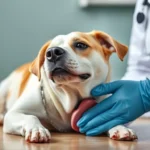
Dog health care is a crucial topic for pet owners, especially as we become more aware of the materials that surround us and our furry friends. One significant concern is the prevalence of plastic in our lives and its potential effects on our pets. With numerous studies indicating that certain plastics can pose health risks, understanding the implications of plastic use is vital for every dog owner.
Statistics reveal that millions of pet products on the market are made from plastic, prompting serious questions about their safety. This article delves into whether plastic is toxic to dogs and what you should know to keep your canine companion safe.
Understanding Plastic and Its Components
What is Plastic?
Plastic is a synthetic material made from polymers, which are long chains of molecules derived primarily from fossil fuels. There are various types of plastics, each with its unique properties and uses. Common types include:
- Polyvinyl Chloride (PVC): Often used in flexible toys and some pet collars.
- Polyethylene Terephthalate (PET): Common in water bottles and food containers.
- Polycarbonate: Used for durable products like certain bowls and toys.
These materials are widely used in everyday pet products, making it essential for pet owners to understand their implications.
Common Chemicals Found in Plastics
Many plastics contain harmful chemicals that can leach into food or water, potentially affecting your dog’s health. Two notorious culprits are:
- BPA (Bisphenol A): A chemical linked to hormonal disruptions and various health issues.
- Phthalates: Often used to make plastics more flexible, phthalates are also associated with hormonal disruption and developmental issues.
These chemicals can leach out, particularly when plastics are heated or scratched, leading to potential exposure for your dog.
Types of Plastics to Avoid for Dogs
Certain plastics are deemed unsafe for dogs and should be avoided. These include:
- PVC: Often contains harmful additives that can be toxic.
- Polycarbonate: Typically contains BPA, which can leach into food and water.
- Plastic that is not marked with recycling codes: Ensure products are certified safe for pet use.
When selecting pet products, look for those that meet industry standards, such as those certified by the FDA for food safety. Opt for items labeled as BPA-free or made from safer materials.
The Risks of Plastic Exposure in Dogs
Potential Health Effects
The potential health effects of plastic exposure in dogs are alarming. Studies have shown that chemicals like BPA and phthalates can disrupt hormonal balance, leading to issues like obesity, diabetes, and even certain cancers. For example, a study published in Environmental Health Perspectives highlighted that dogs exposed to higher levels of these chemicals may face increased health risks.
Signs of Toxicity in Dogs
It’s crucial for dog owners to recognize the signs of plastic toxicity. Symptoms may include:
- Vomiting
- Diarrhea
- Lethargy
- Abdominal pain
If your dog exhibits any of these symptoms, especially after chewing on plastic items, it’s essential to consult your veterinarian immediately.
Long-term Effects of Plastic Exposure
Prolonged exposure to toxic plastics can lead to chronic health problems in dogs. Issues such as hormonal imbalances, developmental disorders, and even cancer can arise from continuous exposure to harmful chemicals. Experts stress the importance of monitoring your dog’s health and being aware of any unusual behavior or symptoms, as early detection can be critical.
Best Practices for Dog Owners
Choosing Safe Products
When it comes to selecting pet products, prioritize safety. Here are some tips:
- Look for non-toxic materials: Choose items made from stainless steel, glass, or natural rubber instead of plastic. These materials are generally safer and easier to clean.
- Check for certifications: Ensure products are labeled as free from harmful chemicals like BPA and phthalates.
Proper Disposal of Plastic Products
Proper disposal of plastic products is essential in minimizing environmental impact and preventing accidental ingestion by pets. Follow these guidelines:
- Recycle responsibly: Always check local recycling guidelines to ensure proper disposal.
- Avoid throwing plastics in regular trash: This can lead to environmental pollution and potential harm to wildlife.
Monitoring Your Dog’s Environment
Keeping your home safe from harmful plastics is vital. Here are some suggestions:
- Remove harmful items: Regularly check for broken toys or containers that may pose a risk.
- Supervise playtime: Be attentive during playtime, especially with new toys, to prevent ingestion of plastic pieces.
- Regular health check-ups: Schedule routine veterinary visits to monitor your dog’s health and discuss any concerns related to plastic exposure.
Alternatives to Plastic
Eco-Friendly Pet Products
As awareness of plastic hazards grows, many brands now offer eco-friendly alternatives for pet products. These options often use sustainable materials that are safer for dogs and the environment. Some notable eco-friendly brands include:
- West Paw: Offers toys made from recycled materials.
- PetFusion: Provides feeding bowls made from BPA-free materials.
Choosing these products not only benefits your dog’s health but also contributes to a more sustainable planet.
Homemade Dog Toys and Bowls
Creating homemade dog toys and bowls can be a fun and safe alternative to store-bought plastic items. Here are a few simple DIY ideas:
- T-shirt tug toy: Braiding old T-shirts can create a durable tug toy.
- Cardboard box puzzle: Hide treats in a cardboard box for a fun and engaging puzzle.
- Glass or stainless steel bowls: Repurpose old containers as feeding bowls.
Homemade options often allow for greater control over materials, ensuring your dog’s safety.
Conclusion
As a responsible dog owner, understanding the implications of plastic use in your pet’s life is essential. Being informed about the types of plastics, their potential health risks, and the signs of toxicity equips you to make better choices for your dog’s health.
By choosing safer alternatives, monitoring your dog’s environment, and being proactive in your pet care practices, you can significantly enhance your dog’s quality of life. Share this information with fellow pet owners to raise awareness about the importance of dog health care and the potential dangers of plastic exposure.
FAQs
Common Questions About Plastic and Dog Health
Is all plastic toxic to dogs?
Not all plastic is toxic, but certain types, such as PVC and polycarbonate, can contain harmful chemicals. Always check for safety certifications.
What should I do if my dog chews on plastic?
If your dog chews on plastic, monitor them for any signs of distress or illness. If symptoms arise, contact your veterinarian immediately.
Are there any safe plastics for dog use?
Some plastics are considered safer, such as those marked as BPA-free. Look for products designed specifically for pet use that comply with safety standards.
How can I tell if a product is safe for my dog?
Check for certifications indicating that the product is free from harmful chemicals. Look for labels such as “BPA-free” and “made from non-toxic materials.”









